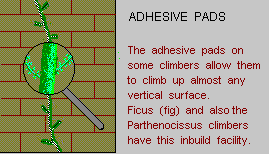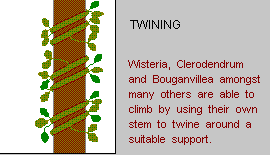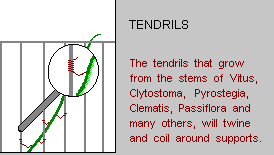Home
Our Loft
Quilts, Gifts, Decorating, Restin' & Relaxin', Pampering
Craftin' Room
Crafts for the
Kid in all of us
Special Occasions
Kids Fun Stuff
Heart of our Home
Recipes, Crafts, Cookbooks, Tips,
Readin' Room
Craft Books, Antiques and Collectibles, Gardening and more
From the Porch
Gardening
Helpful Tips
Products
General Store
Stroll the Aisles
Helpful & Handy Tips
Kitchen, Outside Help, Individual Items
Special Occasions
Crafts & Gifts
About Us Folks
E-Mail
Links
Contact Info
Comfy Country Creations
P.O. Box 10181,
Airdrie, Alberta
T4A 0H5
Phone: 403-912-2645
Fax: 403-912-0543
|
|
Climbers & Vines
 Climbers and Vines can cloth walls, fences, pergolas, trellises and
frames with some of the most magnificent floral displays. All this
and yet they only take up a few cm's of ground space.
Climbers and Vines can cloth walls, fences, pergolas, trellises and
frames with some of the most magnificent floral displays. All this
and yet they only take up a few cm's of ground space.
For courtyards and other small spaces, Climbers and Vines really
come into their own. They are not only beautiful to behold but will
often fill the area with fragrances, give you privacy where you
want it and shelter you from the sun and wind.
 Some Climbers and Vines are deciduous, some are evergreen,
some require support and some will climb by using their own tendrils
and by twining around objects such as pergola supports and
trellises. Some have aerial roots and adhesive pads which they use
to climb brick and concrete walls, or other plants and trees.
Some Climbers and Vines are deciduous, some are evergreen,
some require support and some will climb by using their own tendrils
and by twining around objects such as pergola supports and
trellises. Some have aerial roots and adhesive pads which they use
to climb brick and concrete walls, or other plants and trees.
 A deciduous climber allowed to cover a pergola will shade you
during the hot summer while dropping its leaves in autumn to
allow the sun's rays to penetrate and warm you during the cold
winter months.
A deciduous climber allowed to cover a pergola will shade you
during the hot summer while dropping its leaves in autumn to
allow the sun's rays to penetrate and warm you during the cold
winter months.
 Evergreen climbers supported on a bare fence can turn an eyesore
into a thing of beauty. Mosts vines and climbers require a sunny
position except in the tropics and hot inland areas where they
would benefit from more dappled sunlight.
Evergreen climbers supported on a bare fence can turn an eyesore
into a thing of beauty. Mosts vines and climbers require a sunny
position except in the tropics and hot inland areas where they
would benefit from more dappled sunlight.
The soil should be enriched with organic compost and a similar
mulch should be placed on top of the planting bed. As the mulch
rots down it will add to the plant's food cycle.
Although necessary pruning to maintain the required shape and
spread of your plant can be carried out at any time, generally,
if you prune after its flowering period, you won't miss out on
its beautiful blooms.
NOTE: Graphics are GrowIt Gold (tm)Copyright (c) 1990-2002, Brian Rondel, Innovative Thinking
Software, All Rights Reserved.
Please visit all of our other related pages
Gardening
|